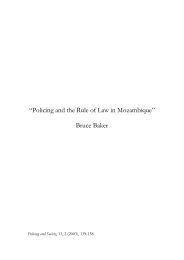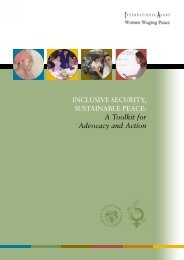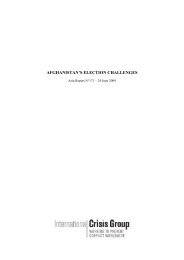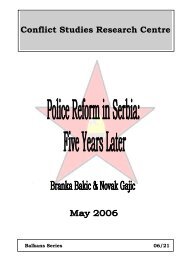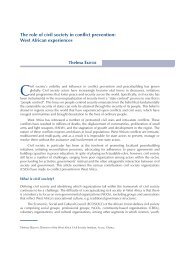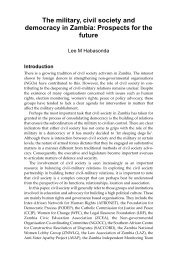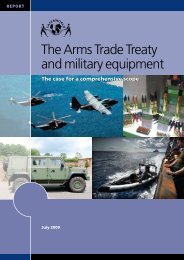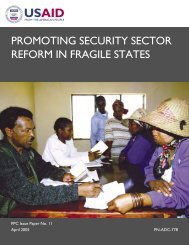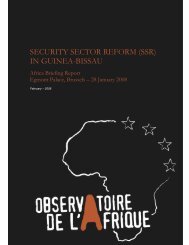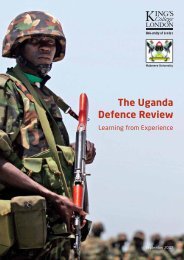small arms and light weapons among pastoral groups in the kenya ...
small arms and light weapons among pastoral groups in the kenya ...
small arms and light weapons among pastoral groups in the kenya ...
You also want an ePaper? Increase the reach of your titles
YUMPU automatically turns print PDFs into web optimized ePapers that Google loves.
SALW AMONG PASTORAL GROUPS 65<br />
enormously s<strong>in</strong>ce <strong>the</strong> late-1970s because of <strong>in</strong>creased supply. At that time,<br />
a gun could cost up to 70–150 cows, as noted by a Jie:<br />
When my family got our gun, we paid 25 heads of cattle. Then <strong>the</strong> guns were very<br />
rare, we bought from dealers from Labalangit. Before 1979 Moroto barracks <strong>in</strong>tervention,<br />
we used to get <strong>the</strong> guns from <strong>the</strong> Turkana dur<strong>in</strong>g peacetime at 150 cattle. 94<br />
Dur<strong>in</strong>g <strong>the</strong> 1990s, <strong>the</strong> cost of a gun was between 10–30 cows. By May–<br />
June 2001, at <strong>the</strong> start of <strong>the</strong> research, guns were be<strong>in</strong>g exchanged for five<br />
to ten cows <strong>in</strong> Upe Pokot <strong>and</strong> three bulls at <strong>the</strong> source. In 2003–4, an<br />
AK47 cost two to three cows at <strong>the</strong> source. A Jie who got guns directly<br />
from Sudan stated ‘We are very happy to buy <strong>the</strong> gun at two cows because<br />
it makes it easy to own a gun’. Consultation with <strong>the</strong> elders <strong>and</strong> some<br />
members of <strong>the</strong> community noted that 40–50 goats are also equivalent to a<br />
gun. In Kenya, prices have reduced from 30–100 cows <strong>in</strong> <strong>the</strong> 1970s,<br />
depend<strong>in</strong>g on <strong>the</strong> area, to three to six cows more recently. Prices at <strong>the</strong><br />
source are lower because of availability. In Moroto, <strong>the</strong> current price of a<br />
gun will be at most five bulls if sold to a fellow Karimojong resident with<strong>in</strong><br />
Ma<strong>the</strong>niko <strong>and</strong> Bokora. But, at <strong>the</strong> cross-border level, if sold to a Turkana,<br />
<strong>the</strong> Turkana will have to pay five to eight oxen or more for an orig<strong>in</strong>al<br />
Russian AK47.<br />
The weekly markets at Kangole (Mondays) <strong>and</strong> Moroto (Thursdays) are<br />
different <strong>in</strong> that cash is <strong>the</strong> means of exchange ra<strong>the</strong>r than barter. Those<br />
who use <strong>the</strong>se markets are look<strong>in</strong>g to generate cash, which is required to buy<br />
certa<strong>in</strong> consumer goods. At <strong>the</strong>se markets, <strong>the</strong> go<strong>in</strong>g rate for a gun <strong>in</strong> 2001<br />
was around 150,000 UgSh, which is equivalent to approximately UK£45.<br />
The price <strong>in</strong> 2003–4 was between 200,000 <strong>and</strong> 400,000 UgSh per gun. At<br />
Nakapelimoru <strong>and</strong> Panyangara <strong>in</strong> Kotido, which are near <strong>the</strong> source, <strong>the</strong><br />
2005 prices ranged from 250,000 to 350,000 UgSh or three to five bulls. 95<br />
The recent <strong>in</strong>creases may be expla<strong>in</strong>ed by <strong>the</strong> disarmament attempts <strong>in</strong><br />
2001 <strong>and</strong> s<strong>in</strong>ce September 2004 till date. One must ask <strong>the</strong> question whe<strong>the</strong>r<br />
this is expla<strong>in</strong>ed by reduced supply because of <strong>the</strong> collection of guns or by<br />
<strong>in</strong>creased dem<strong>and</strong> because of <strong>the</strong> community’s perceived need to re-arm.<br />
The type of guns also determ<strong>in</strong>es <strong>the</strong> price. The commonest gun is <strong>the</strong><br />
AK47. The SAR (Ch<strong>in</strong>ese made) is however cheaper, cost<strong>in</strong>g 150,000–<br />
200,000 UgSh or one to two cows at <strong>the</strong> source. The G3 is more expensive,<br />
because it does not get hot <strong>and</strong> because it is rare, which is to <strong>the</strong> credit<br />
of <strong>the</strong> Kenya government which is <strong>the</strong> ma<strong>in</strong> source! With <strong>the</strong> <strong>in</strong>troduction<br />
of cash sales, <strong>arms</strong> traders can buy highly desirable goods such as radios,<br />
mobile phones (a network was placed <strong>in</strong> Karamoja <strong>in</strong> 2003), <strong>and</strong> general<br />
94. Interviews <strong>in</strong> Karamoja, 2001–4.<br />
95. Interviews with warriors <strong>and</strong> o<strong>the</strong>rs, Nakapelimoru <strong>and</strong> Panyangara, August 2005.




